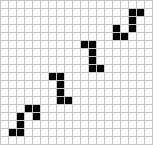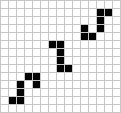Pentoad
Pentoad (or eater-bound Z-hexomino[1]) is a period-5 oscillator that was found by Bill Gosper in June 1977. It consists of a Z-hexomino that is stabilized by two eater 1s.
| Pentoad | |||||||||||
| |||||||||||
| View animated image | |||||||||||
| View static image | |||||||||||
| Pattern type | Oscillator | ||||||||||
|---|---|---|---|---|---|---|---|---|---|---|---|
| Number of cells | 20 | ||||||||||
| Bounding box | 13×12 | ||||||||||
| Period | 5 | ||||||||||
| Mod | 5 | ||||||||||
| Heat | 8.8 | ||||||||||
| Volatility | 0.65 | ||||||||||
| Strict volatility | 0.65 | ||||||||||
| Discovered by | Bill Gosper | ||||||||||
| Year of discovery | 1977 | ||||||||||
| |||||||||||
| |||||||||||
| |||||||||||
| |||||||||||
It was discovered by Scott Kim that this oscillator is extensible by moving one of the eaters diagonally away by four cells and inserting another Z-hexomino in the gap.[2] A pentoad constructed in this way with n Z-hexominoes has 14 + 6n cells and heat 8.8 + 6.4n. The pentoad with two Z-hexominoes is shown below.
Image gallery
 |
gollark: That's an awful workaround which will probably break something for someone, when the solution is just a sane format with working escaping.
gollark: Ah, a more reasonable 112kloc of nonvendor code.
gollark: I didn't exclude dokuwiki's vendor folder, so hold on.
gollark: No idea, don't have it.
gollark: It's DokuWiki.
References
- Mark D. Niemiec. "Eater-bound Z-hexomino glider synthesis RLE file". Retrieved on April 28, 2009.
- Dean Hickerson's oscillator stamp collection. Retrieved on March 14, 2020.
This article is issued from Conwaylife. The text is licensed under Creative Commons - Attribution - Sharealike. Additional terms may apply for the media files.
